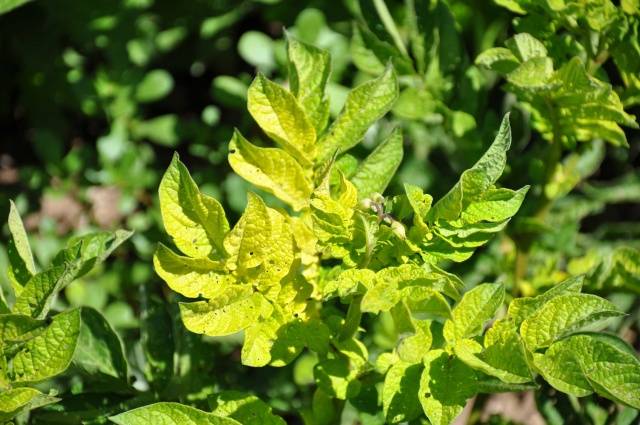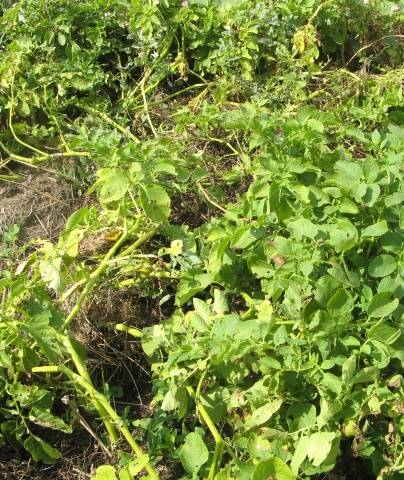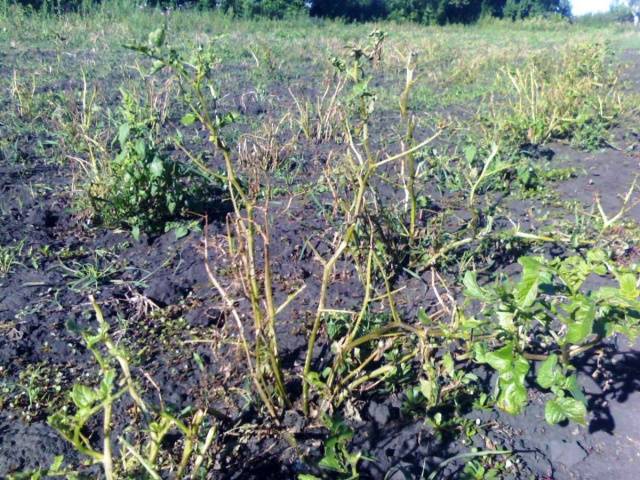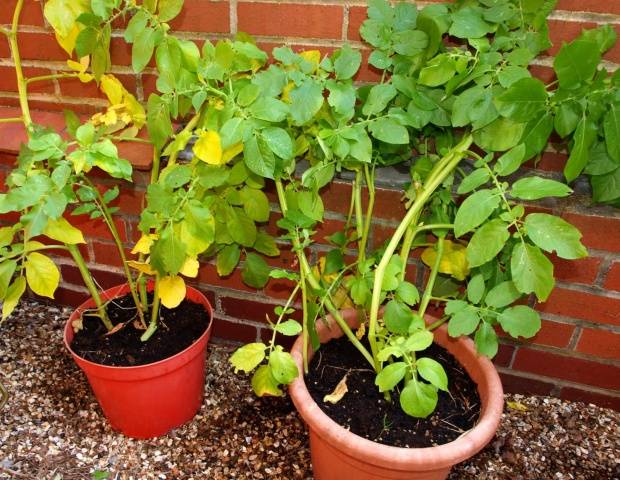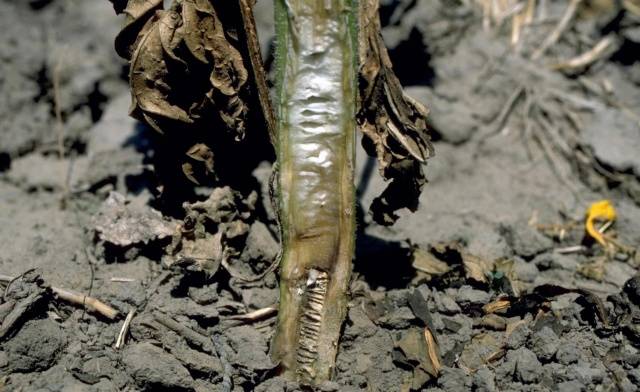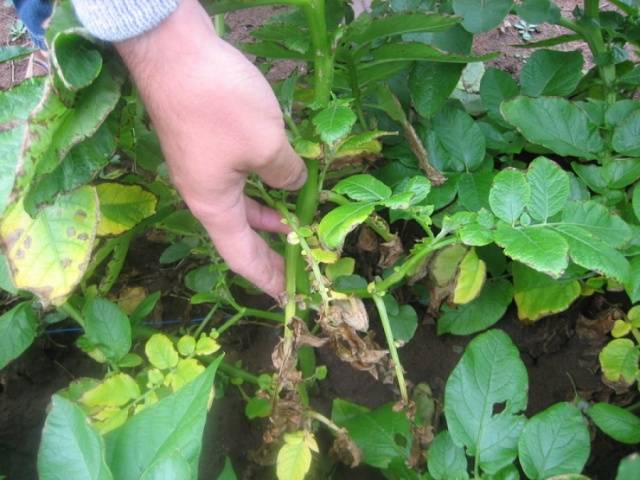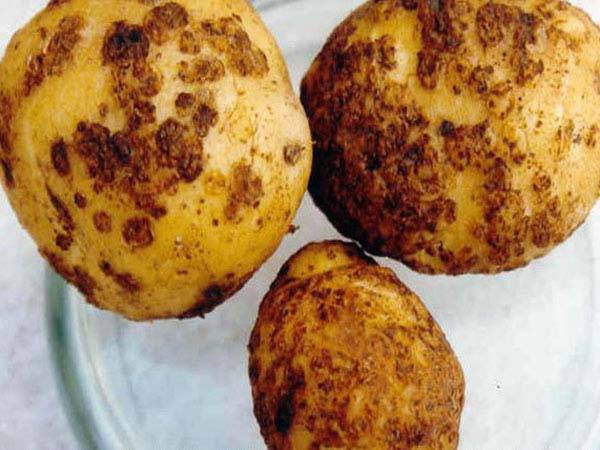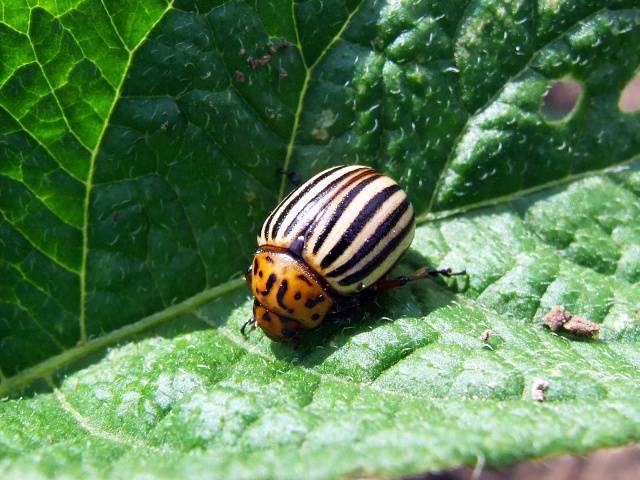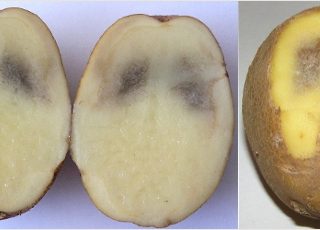Content
Potato tops wilting is a natural process that occurs at harvest time. If the foliage turns yellow before this time, then this indicates a violation of the vegetation process of plants.
Reasons why it turns yellow potato topsare very diverse. This includes high air temperatures, lack of nitrogen, phosphorus and other fertilizers. Yellow leaves often indicate the spread of diseases or pests.
Causes of yellowing of potato tops
Temperature and humidity
The main reason for the wilting of potato tops before harvest is a violation of the temperature regime. In drought, potato leaves begin to turn yellow from below, gradually this negative phenomenon spreads to the entire bush.
Constant rains or excessive moisture will not correct the situation. Then a crust forms on the surface of the soil, which prevents the flow of air to the root system.
If the temperature reaches 30 degrees, then the metabolism is disturbed in the plant. As a result, the yield of potatoes decreases.
During the growing season, soil moisture indicators should remain at 70%. In arid regions, irrigation is required for plantings. The need for additional moisture increases with flowering potatoes.
During the period of tuber formation, it is necessary to ensure the supply of oxygen to the soil. For this, the soil is periodically loosened.
Lack of fertilizer
The tops of potatoes turn yellow when the intake of nutrients is insufficient. Most often, plants are deficient in the following substances;
- Nitrogen... If there is not enough nitrogen in the soil, then the leaves of the potato turn pale green, after which they turn yellow and fall off. When nitrogen is supplied, the plant grows green mass and forms new tubers. 10 kg of root crops require up to 50 g of nitrogen-containing substances. For feeding, mineral compounds are used, which are introduced into the soil before planting the tubers.
- Phosphorus... Phosphorus fertilization helps the development of the root system, accelerates the formation of tubers and increases the starch content in them. When there is a lack of phosphorus, plants do not tolerate hot weather worse. As a result, the potato does not grow to the required height, and its leaves turn yellow. One hundred square meters requires up to 0.9 kg of superphosphate. It is better to apply fertilizer in the fall, so that easily digestible forms of phosphorus are formed in the spring.
- Potassium... Due to potassium, the immunity of plants is increased, the palatability and shelf life of tubers are improved. With a lack of potassium, the process of photosynthesis is disrupted, and plants are less tolerant of drought. Potatoes are fertilized with potassium sulfate, which is applied in the fall or spring before planting. The fertilizer rate is 1 kg per weave.
- Iron and manganese... With a lack of iron and manganese, potatoes wilt. Top dressing with potassium sulfate will help to correct the situation. A bucket of water requires 5 g of fertilizer, after which the bushes are watered at the root. To spray potatoes, a solution of copper sulfate is prepared (50 g per bucket of water). The procedure is carried out every 5 days.
Disease development
Early yellowing of the tops is often associated with the development of diseases:
Verticillary wilting
If the leaves of the potatoes turn yellow and dry, this is a sign of a viral infection. Verticillium wilting spreads at temperatures ranging from 17 to 22 degrees. Dark spots form on the cut of the potato stalk. With the development of the disease, the bush must be removed from the site. To prevent wilting, plantings are treated with a solution of copper oxychloride.
Fusarium
If the yellowness spreads from the top of the potato, this is a sign of fusarium. The disease develops in high humidity in cool climates. In this case, it is impossible to save the planting, therefore it is necessary to eliminate the affected plants.
For the prevention of fusarium, the rules of crop rotation must be observed. The planting material is processed for disinfection.
Phytophthora
If the tops in the lower part of the bush have turned yellow, this is the first symptom of late blight. At the same time, dark spots are formed along the edges of the leaf plate, gradually spreading to the entire bush.
What to do when phytophthora is spread? Potatoes must be treated with fungicides: copper oxychloride, "Cuproxat", "Ditamin".
Dry spot
The disease appears on potato leaves two weeks before flowering. First, rounded brown spots appear on the tops of potatoes, which gradually grow. Dry spotting is determined by the presence of yellowed tops.
The causative agent of the disease is a fungus. To combat it, chemical preparations are used: "Quadris", "Oksikhom", "Ridomil".
Pest attack
Potatoes are susceptible to various pests, under the influence of which the tops acquire a yellow color:
Nematode
The potato nematode lives in the ground and feeds on the sap of the plant root system. As a result, the stem and leaves of the potato turn yellow. The nematode leads to the death of the crop, which can be up to 80%.
To combat the nematode, fescue, lupine, marigolds, rye, oats or peas are planted next to the potatoes. Before planting the tubers, urea is introduced into the soil (1 kg per hundred square meters).
Colorado beetle
One of the most common pests in the garden is the Colorado potato beetle. This insect eats the tops of potatoes, which leads to their wilting.
Cope with the Colorado potato beetle allows the use of special preparations: "Iskra", "Bankol", "Commander" and others. For processing, you need to make a solution. The procedure is carried out during the growing season of the plants before the start of the harvest.
You can plant calendula, beans, marigolds, tansy next to potatoes. These plants have a strong odor that repels the pest.
To get rid of the Colorado potato beetle, folk methods are used: an infusion is prepared based on dandelion, celandine or garlic.
Conclusion
When yellow leaves appear in potatoes, it is necessary to analyze the conditions in which the plants grow. The irrigation and fertilization scheme must be corrected. If diseases or pests are detected, the plantings are treated with chemicals. For prevention, tubers are treated before planting, and marigolds, calendula and other useful plants are planted next to the plantations.
